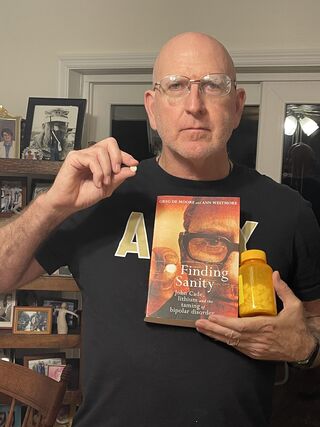Actors, Institutions, and Networks
My recovery could not happen without myriad actors, institutions, and networks among those actors and institutions. When I wasn’t enough, my family saved me. When family wasn’t enough, friends helped out. When friends did all they could, institutions were necessary. When the institutions had done all they could, it was once again family who stepped in.
First among those actors were my wife and family members who refused to quit on me. My wife, Maggie, calls her secret the “P” word, for perseverance. She just kept on going, one foot in front of the other, one day at a time, while I was a virtual zombie.
After a year of paranoid delusions, my youngest son, Conor, pushed me to call my former boss, Lieutenant General Tom Bostick, to confirm or deny my psychotic belief that I was under surveillance and would be arrested. When Tom heard me, he was shocked and worked to connect me with mental health experts.
For nearly 15 months I had been too terrified and depressed to ask, afraid that my inquiry would speed up my arrest. It required a few conversations to believe these assurances, but once I allowed myself to trust them, my delusions faded, although depression still held me in its unyielding grip. I’m forever in Conor’s debt for that extra push, and to Tom for his empathy. Tom never abandoned me, and he treated me like the wounded comrade I was. He lived up to the Soldier Creed to “never leave a fallen comrade.”
Second was another long-time Army friend, Colonel (Retired) Bill Barko. Although my family supported me, making sure I was breathing and eating, we needed someone with professional expertise to help get the proper medical treatment. I was seeing a local doctor, but the fit was lacking. Bill realized I needed a more powerful intervention. I needed the right inpatient care, with the right team. Bill made it happen. Relentless in facilitating and holding my wife’s and my hands, he got me into the particular VA hospital I needed. Sometimes we need a helping hand.
The staff at the VA hospital in White River Junction, Vermont, saved my life. I lived there for six weeks—two weeks inpatient and four more living in the hospital dorms. My VA team was a game-changer, trying different medications, psychotherapy, electroconvulsive therapy (14 treatments), chaplain counseling, marriage counseling, and more. But, even with world-class care, I remained deeply depressed and hopeless. My lifelong go-to of prayer, Bible verses, religious music, and positive thinking now had little effect. Nor did exercise.
Exasperated by my unyielding depression, Maggie pushed me and my psychiatrist to try stronger medicine. In August 2016—two years after mania shattered my career—we began lithium, a natural salt and proven mood stabilizer. Unfortunately, lithium comes with negative side effects, which up until then, we had avoided. Astoundingly, within a week of starting lithium, I felt better, rising up out of depression. Soon, I had new energy and hope and began to enjoy life. Lithium constructed a floor and ceiling inside my brain: the floor prevented me from sinking back into depression, and the ceiling kept me from shooting back into mania. Like a magic bullet, lithium worked—and continues to work—despite negative side effects, principally hand tremors. Lithium works wonders for me and many bipolar patients.
Building a New Life
Weeks after commencing with lithium and rising out of depression, Maggie and I relocated from New Hampshire to Florida, with its near endless summer, bright sun, and warmth. In addition to the subtropical climate, we live in a fun community of happy, energetic, friendly people who enjoy the healthy, laid-back lifestyle. We’ve built a new life.
But I will always have bipolar disorder. It’s an inextricable part of my brain and who I am. There is no known cure. Yet it can be managed, and people with bipolar can live healthy, fulfilling, successful lives. The list of successful, famous people with bipolar is long and includes stars and leaders in virtually every profession.
The keys to my staying healthy and preventing another onset of mania or depression, are to religiously take my medications; get plenty of sleep; exercise regularly, and stay fit—mind, body, spirit, and emotions; eat a healthy diet; cultivate friendships; construct guardrails to avoid and protect myself from stressors and cultivate calmness; and have fun and enjoy life.
Medications, therapy, and healthful living are necessary but not sufficient for a recovery that’s built to last. I’ve anchored myself on the social foundation of the 5P’s: People, Place, Purpose, Perseverance, and Presence.
- People: I developed a network of happy, upbeat, interesting friends that I enjoy being with; Maggie and I live our “make-a-friend and be-a-friend” (MAF-BAF) life strategy every day.
- Place: We get to live in a beautiful, safe place that makes us feel good and energized.
- Purpose: I discovered and live my life mission—“sharing my bipolar story to help stop the stigma and save lives”—and making my life count for something greater than myself!
- Perseverance: I’ve infused my life with the will to recover—to never give up!
- Presence: I’ve learned to get outside of my own mind and objectively see and adapt to what’s happening, to dance to the music that’s actually playing as opposed to what I hear in my own head, and to practice “metacognition,” by thinking about my own thinking.



